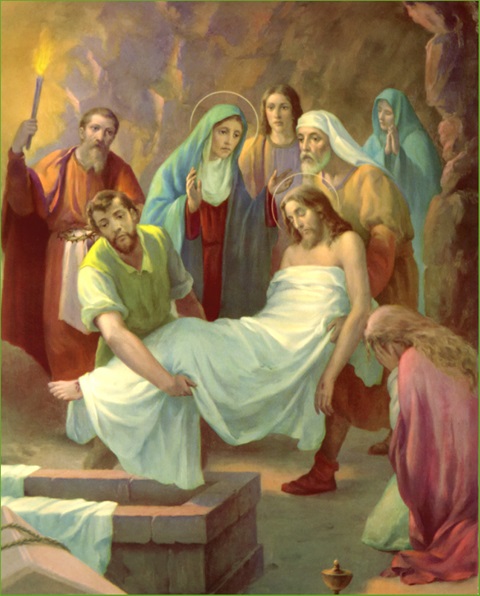TO THE MOTHER MOST DESOLATE
(Meditation on Good Friday, and other Fridays)
In honour of the Blessed Virgin Mary, in her desolation after the death of her Divine Son.
Amongst all the sorrows and sufferings of our Blessed Mother, one of the most intense and the least known and venerated, is the bitter anguish she experienced when Jesus was laid in the Sepulchre and she was left alone in her desolation.
Pope Pius VII of holy memory, who had a deep devotion to the Sorrows of the Blessed Virgin Mary, enriched this devotion with many Indulgences, recommending it to the fervent practice of the faithful, and by a rescript of the Sacred College of Indulgences dates June 18, 1822, granted –
1. A Plenary Indulgence to all those who from three o’clock on Good Friday until mid-day on Holy Saturday (the hour on that day when Holy Church invites the faithful to rejoice in the resurrection of Jesus Christ), shall, either in public or in private spend one hour, or at least one half hour, in honour of most Blessed Mary in desolation, by meditating on her Seven Dolours, or any other meditations and prayers having reference to her desolation. This indulgence is gained when by Confession and Communion they fulfil the precept of Paschal Communion.
2. An Indulgence of 300 days, on other Fridays, whenever between three o’clock on that day and the dawn of Sunday, they practise this devotion.
3. A Plenary Indulgence each month to all who have practised it every week in the month provided they go to Confession and Communion on one of the last days of the devotion.
Meditation - I
Mary at the Holy Sepulchre.
Let us meditate on the sufferings of Mary as she stands by the tomb.
Let us look on that face of bitter anguish and desolation. A short time before, and the sacred Body of Jesus disfigured and covered with wounds and bruises had rested in her arms! but now Jesus is no longer present! Mary had shared with her Divine Son all the Sufferings of His Passion, but now she is alone in her grief, for Jesus is no more. Oh! what grief is like unto her grief! Let us ask ourselves who has caused all this sorrow? It is I, O! my Mother, it is my sins that crucified thy Son. It is thy adopted child who has bereaved thee of thy Own! Had it not been for sin, Jesus would never have died.
Colloquy. O! Blessed Mother, Mother of Mercy, have pity on me, accept the tears of a truly contrite heart, and offer them in union with those thou didst shed at the Holy Sepulchre, to Jesus thy Divine Son, that they may be accepted in expiation of past sin. Grant that I may never forget thy sorrows, and never again by fresh sin crucify my loving Saviour.
Prayer. One Glory be to the Father, &c., seven Hail Marys, and the first verse of the Stabat Mater.
Practice. Consider in the presence of God what particular sacrifice He requires of you, resolve generously to offer it.
Aspiration. Most Sorrowful Virgin, pray for us.
Meditation - II
Mary, in returning to her home, passes by Calvary.
Let us follow Mary when she leaves the Holy Sepulchre.
St. John, the beloved disciple of Jesus, and the holy women are with her. She must pass one by one the hallowed stations of her Divine Son’s Passion. Let us meditate more especially on the sufferings of her sorrowful heart when she sees Calvary again, and the Cross on which Jesus a few hours before was crucified. She sees the ground beneath the Cross crimsoned with His Precious Blood. Oh! what a flood of bitter recollections deluges her soul at that moment! The three hours agony when she stood watching her dying Son! noting each bleeding gash of His lacerated Body, hearing the insults and blasphemies poured out against Him, seeing that chalice of humiliation, the gall and vinegar presented to His lips, listening to His last expiring words, His prayer for his enemies, and those words of bitter anguish and last farewell addressed to herself – “Behold thy Son.” And Mary kneels at the foot of the Cross, and clasps again and again the hard wood, and kisses the stains of the Precious Blood which has brought salvation to her newly- adopted children.
Colloquy. O! Mary, these words – “Behold thy son” have sunk deep into thy heart, and will never be forgotten by thee.
Have we ever realized that Christ dying for us bequeathed to us what He most prized on earth, His own most beloved Mother to be ours? Have we ever realized the blessed privilege of being able to call her “Our Mother.”
O! Mother of Sorrows! As thy life was one of continual grief, teach us like thee to love the Cross; let us in adversity share thy fortitude, and if ever a day should come when we feel weighed down by trouble and grief, then let us kneel in spirit as its foot, and remembering the parting gift of our dying Lord, invoke thy holy protection, and through the merits of those sufferings endured on Calvary, obtain peace of mind and resignation to the will of God. Teach us, O! Blessed Mother, to love Jesus as thou didst love him, in suffering and humiliation, and obtain for us a true devotion to His Passion.
Prayer. Seven Hail Marys, and the second verse of the Stabat Mater.
Practice. Let us lay at the foot of the Cross whatever evil propensity is most opposed to the reign of Jesus in our souls, and devote our hearts to His love and that of Mary in her Sorrows.
Aspiration. Mary, Queen of Martyrs! pray for us.
Meditation - III
Mary in her Solitude.
Let us follow Mary when she return to the city of Jerusalem. St. John has taken her to his own home. Let us enter that house and remain awhile with our Mother in her Solitude.
Let us taste that feeling of utter desolation that pierces afresh her sorrowing heart! Mary is weeping bitterly, for great indeed is her affliction and sorrow, even as the sea. There is none now to gladden her heart, for Jesus, her joy, her comfort, and her all, is gone from her.
“Weeping she weeps; there is none to console her among all that are dear to her, because the Comforter, the relief of her soul is gone from her.” (Lam. i, 2-16). “The Glorious One of Israel has forsaken her.” (Ib. ii, 1-10.) “The Breath of her mouth, Christ the Lord, is taken away.” (In. iv. 20.) “Therefore does the Virgin of Jerusalem hold her peace, and sprinkle her head with dust, and gird herself with hair cloth.”
Jesus and Mary had been companions in joy and in sorrow, and no words can express their intimate union. Mary has shared even the childish griefs of Jesus. She had been the friend of His maturer years, and the companion of His lonely hours. She has shared His poverty, His humiliations, and the agony of His Passion. She clung to Him when all others had forsaken Him, and most willingly would she have laid her head in the grave of her Divine Son. But Jesus has departed from her, and Mary is alone; alone in her sorrow. How desolate is our bereaved Mother. How intense the anguish of that martyred heart! She has indeed drunk the chalice even to its dregs.
Every action of Mary’s life was fulfilled with a view to Jesus, was directed solely by the love of Him, and was done for His eyes alone. It was this banishment from His sight, the severing of that close union with Him, that bitter separation from her Son which flooded her immaculate heart with the uttermost desolation.
Colloquy. O! most sorrowful Mary! If ever we should be overcome by that most cruel desolation of soul, and Jesus should leave us and hide Himself, so that we can nowhere find rest or consolation in prayer, let us then turn to thee, O! Mother of Mercy! And invoking thee by the merits of the sorrows endured in thy desolation, may our past negligences be pardoned, and the light of thy Son’s Countenance shine again upon our souls.
Grant us, O! Mother, such a tender devotion to thy sorrows, and above all to the Passion of Christ which caused them that we may be daily more purified from sin, and finally be admitted to reign with thee and thy Divine Son for all eternity.
Prayer. Seven Hail Marys, and the third verse of the Stabat Mater.
Practice. Detachment from the things of this world. Frequently to beg of God the great gift of true devotion to the Blessed Virgin.
Aspiration. O! Mother most desolate, pray for us now, and at the hour of our death.
Source: Manual of Devotions of Our Lady of Sorrows, Edition 1861


